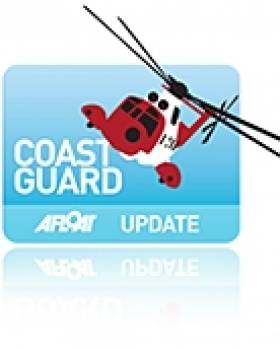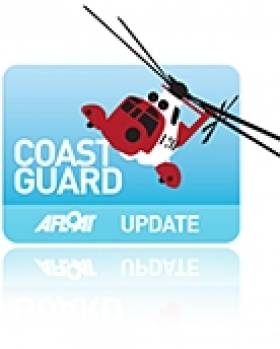Displaying items by tag: S92
S92 Search & Rescue Helicopter Launched in Dublin
#coastguard – Minister for Transport, Tourism & Sport Leo Varadkar officially launched the Coast Guard's new state-of-the-art S92 search & rescue helicopter for the Dublin region in Weston Airport today.
This is the fourth and final Sikorsky S92 helicopters to come into operation for the Coast Guard and means the entire fleet has now been upgraded. It replaces the Sikorsky S61 which was in use until recently at Coast Guard bases in Dublin, Shannon, Sligo and Waterford.
Speaking at the launch Minister Varadkar said: "This new helicopter means the Irish Coast Guard now has one of the most modern and effective helicopter fleets in the world. The S92 is tailored specially for search & rescue operations. It has an extended range of 270 nautical miles, is faster and safer, can carry more casualties, and can fly at higher altitude and in much worse weather.
"I'm delighted that the entire Coast Guard helicopter fleet has now been upgraded. It comes after one of the busiest years ever for the Coast Guard which responded to 2,627 incidents involving fishing craft, leisure vessels and mountaineers. A well-equipped and well-resourced Coast Guard can represent the difference between life and death for anyone in trouble at sea or on land.
"The new helicopters also allowed the Coast Guard to expand its role in providing emergency medical transport for the HSE. Last year the Coast Guard performed 253 aeromedical missions and 159 offshore island medical evacuations.
"This is a good occasion to pay tribute to the dedicated helicopter crews who work tirelessly to rescue lives all year round, and also the hundreds of volunteers on Coast Guard and RNLI vessels, mountain and cave rescue teams. It wouldn't be possible to provide the same level of emergency response without these volunteers. That's also why we have the highest ever allocation of €67.9 million for the Coast Guard in 2014 to finance the provision of critical search & rescue services."
Coast Guard Director Chris Reynolds said: "This has been an exceptional year in terms of the number of incidents, but there has been significant progress in terms of modernising and further developing the Coast Guard. The new helicopter fleet will greatly enhance our capacity to provide a first-class response to all emergencies in the year ahead, whether off-shore and inland."
The Coast Guard also announced a competition to name all four of the new helicopters. The nationwide competition will kick off next week and will be featured on Clare FM, Ocean FM, FM104, Q102 and WLR, including their Facebook sites. Listeners will be invited to send in their suggestions to these radio stations. The aim is to raise awareness locally of the new Coast Guard helicopters, and to inform people about how best to alert the Coast Guard or other emergency services in the event of an incident.
Enhanced medical capacity of Sikorsky S92
The S92 and its well-trained crews including State-registered paramedics can now provide a first class medical service in emergencies and for medical transfers.
Inter-hospital transfers, donor organ recipient transfers, specialist medical teams can now be transported in this modern, reliable and safe aircraft which with its large multi role cabin and rear access ramp which can accommodate stretchers, hospital trolleys, incubators, equipment and personnel .
It can also transfer specialised Ambulance Response and Mountain Rescue teams to an incident anywhere in the country at very short notice, for example train or bus crash or RTA (road traffic accident) requiring multi casualty evacuation.
The Coast Guard has surveyed over 50 landing sites countrywide but has focused mainly on needs in areas where road transport may not benefit the patient if urgent transport was required, especially in terms of transferring people to a centre of excellence within the 90 minute window which is the requirement in the majority of cases when a casualty needs immediate medical attention at a nominated medical centre as directed by HSE staff.
The area of operation in the Irish EEZ (Economic Exclusion Zone) will also be expanded to nearly 300 miles offshore and using the S92's satellite communications, long-range and discreet communications suite, which means that casualty information can be transmitted to the receiving hospital.
Technical information on Sikorsky S92
The capability to be on-scene to a maritime incident in any weather conditions in a shorter time period is largely enhanced due in the main to four main attributes of the aircraft:
Speed: Up to 150kts and doesn't lose speed at altitude, will carry 22 casualties at max range with twin engines each delivering 2500 SHP.
Range: Will have an ROA of 270mls from Waterford and can enhance that with auxiliary tanks.
De-icing: In adverse weather where rotor icing is an issue this aircraft can fly at 10.00ft in conditions of minus 40dgs C.
Performance: Modern reliable engines which deliver more power coupled with three programme linked navigational software , searchlight capability of 30 million candle power , dual high speed winches, high resolution picture zoom, memory mapping, adjacent aircraft detection capability, hi-tech communication systems, large multi role cabin, HEMS licenced, 8 passenger seats, reliable single engine performance, enhanced hover performance and in-flight homing equipment.
The Department of Transport and Coast Guard are members of the Marine Safety Working Group which promotes the importance of water safety for professional and leisure users.
Initiatives launched in 2013 included:
• Slipway signage advising people to use a Personal Flotation Device (lifejacket).
• Launch of new safetyonthewater.ie website
• New Poster Campaign promoting the use of Personal Flotation Devices and communication/alerts devices.
• Promotion of Water Safety on RTE's Search & Rescue show and a new Coast Guard water safety advertisement for TV.
• Wristband IDs for children using the beach or other recreational facilities.
The Marine Safety Working Group comprises:
Irish Coast Guard (IRCG),
Irish Maritime Administration of the Department of Transport, Tourism & Sport,
Irish Water Safety,
Waterways Ireland,
Health and Safety Authority,
Royal Lifeboat Institution,
Bord Iascaigh Mhara
Met Eireann
Irish Sailing Association(ISA).
Coastguard Takes Delivery of New Chopper
#COASTGUARD - The Irish Coast Guard has taken delivery of its new search and rescue helicopter at its Shannon base, The Irish Times reports.
As previously reported on Afloat.ie, Sikorsky completed production of the new S-92 helicopter for the Irish Coast Guard last December under the rescue service's €500 million deal with CHC Ireland to revamp the aircraft fleet.
The deal will also see the coastguard's remaining four Sikorsky S-61s replaced by second-hand S-62s from Scotland over the coming months.
Training with crews at Shannon is set to begin shortly ahead of the S-92's first public demonstration at the centenary of the Titanic’s departure from Cobh in Cork Harbour.
Meanwhile, it is expected that the Air Corps may be offered an upgraded air ambulance role, after they were ruled out as contenders for search and rescue work amid some controversy.
The Department of Health has reportedly been in exploratory talks with private firms regarding the provision of an inter-hospital emergency air transfer service, as called for by the Roscommon Hospital Action Group.
The Irish Times has more on the story HERE.






























































